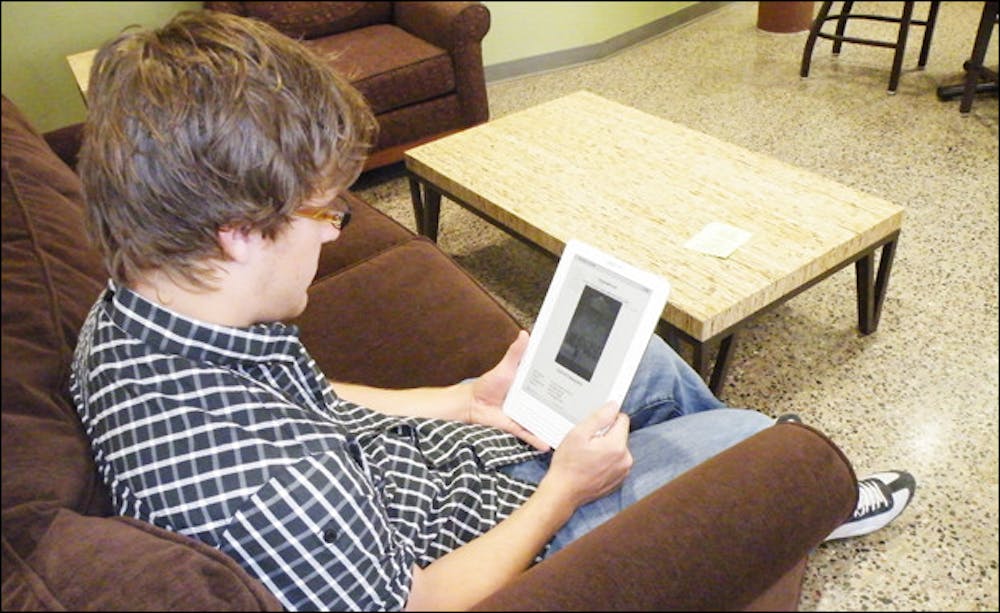Students enrolled in the three Human Event classes using the Amazon Kindle DX pilot are having mixed reactions about using the technology.
Economics freshman Ryan McKenna likes the portability the Kindle provides, but said it is lacking in other areas.
“For a lot of classes, I would think the Kindle would need to get color first,” he said. The Kindle doesn’t have a backlight, front light or the ability to show color. This could be a problem in math classes that use charts or graphs, he said.
McKenna said he’d prefer a better keyboard and a faster processer because pages sometimes take a while to load.
“I miss [regular] books,” he said. “I like to flip pages … I miss the substantiality of a text. It feels like you actually have something.”
Though McKenna said he hopes Amazon works to improve some aspects of the Kindle, he likes its functionality for the most part.
“Using the Kindle has made things a lot faster,” he said. “After class is done, I’ll probably use the Kindle.”
The Kindle is convenient because every book for class can be stored in one place, while it would be difficult to carry a heavy stack of books every day, McKenna said.
Creative writing freshman Dominique Brigham said the minor programming problems don’t bother her.
“They’re going to fix everything,” she said. “This is only the third version … it’s going to improve.”
Brigham said Kindle’s lack of a backlight and touch screen is comparable to early iPods, and is not a big issue for her, since it still does what it should.
“I think its used really well in class,” Brigham said.
The only complaint she had was about the searching technology.
The search function is not easy to use, she said, adding it takes a long time and sometimes does not give accurate results.
Professor of philosophy Ted Humphrey originally proposed the pilot in 2008.
“I thought that the use of the Kindle could be very helpful in saving students money and saving on the use of paper,” he said.
A grant from Amazon and another from the Office of the Provost are funding the pilot, Humphrey said.
“So far, it’s gone better than I expected,” he said.
Humphrey said a few technical problems need to be tweaked if the Kindle is going to be an optimal device for students.
The device could use programming changes to make navigation easier, he said.
A great feature the Kindle offers, Humphrey said, is the ability for students to upload notes they have taken on the device to their computers, making it easy to copy and paste text into papers they write.
The device costs $489, Humphrey said, and the downloaded texts are discounted. For the trial period, students receive the device for free, but after the trial program, other students would have to purchase it themselves.
“Amazon is preparing to offer the Kindle DX through our computer store,” he said.
Some students aren’t sure, however, that this is affordable for everyone. McKenna said he thinks that for the Kindle to be successful something has to change.
It’s still cheaper to buy used textbooks than invest in the Kindle and buy electronic texts, he said, adding that many students aren’t able to afford the high upfront cost and won’t pay it if they don’t see a future return.
“They really have to cut [electronic] textbook prices down,” he said.
Though ASU is still in the process of calculating exact results of the survey, the response seems to be positive, an official from the University Technology Office said.
Anecdotal evidence has shown that students are responding well to using Amazon’s Kindle, said Assistant Vice President Kari Barlow.
ASU is trying to figure the difference in cost between regular textbooks and the Kindle, as well as the study habits of the students who use it, she said.
When the pilot with Amazon was originally proposed, Barlow said the response from faculty was overwhelmingly positive.
“When I put out an e-mail to see who was interested, I got 90 e-mails back within 24 hours,” she said.
Reach the reporter at ndgilber@asu.edu.




